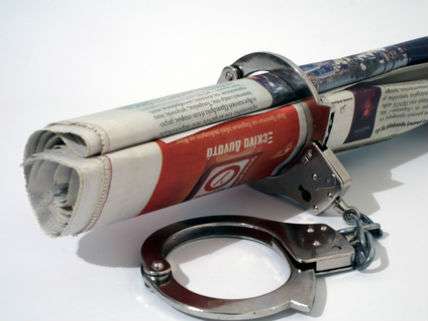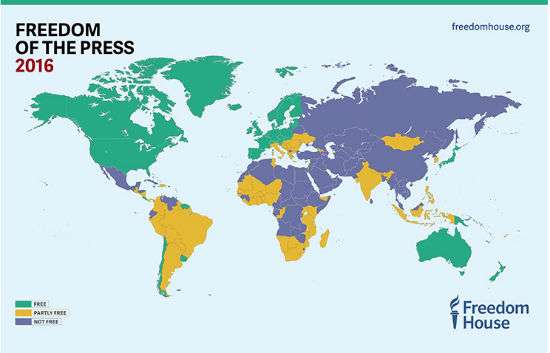Global Press Freedom at 12-Year Low
The real fake news is calling the free press an enemy of the people.

"A few days ago I called the fake news the enemy of the people, and they are—they are the enemy of the people," declared President Donald Trump at the annual Conservative Political Action Conference in February. Fake news like negative polls, inaugural crowds, and three to five million illegal voters? Now the Russian Foreign Ministry has gotten into the business of branding news stories as fake. The Chinese government has joined in denouncing as "fake news" reports that it tortured a human rights activist. "Trump's attacks on the media will offer a good excuse for Chinese officials to step up their criticism of Western democracy and press freedom," said Qiao Mu, a journalism professor at Beijing Foreign Studies University in The New York Times. "China can turn to Trump's attacks to say Western democracy is hypocrisy."
The new report from Freedom House, Freedom of the Press 2016, finds that only 13 percent of the world's people live in countries where there is freedom of the press. In 2003, 20 percent did. That means that 87 percent of the world's people now have to endure fake news peddled and enforced by government thugs daily. There's worse news. "Press freedom declined to its lowest point in 12 years in 2015, as political, criminal, and terrorist forces sought to co-opt or silence the media in their broader struggle for power," notes the report. Freedom House director of research Jennifer Dunham writes:
The share of the world's population that enjoys a Free press stood at just 13 percent, meaning fewer than one in seven people live in countries where coverage of political news is robust, the safety of journalists is guaranteed, state intrusion in media affairs is minimal, and the press is not subject to onerous legal or economic pressures.
Freedom House began issuing its annual world press freedom reports in 2002 measured on a 100-point scale that evaluates the legal, political, and economic environment of each country with respect to media freedom. In 2004, the United States scored 13; in the 2016 report that score had risen to 21 points. In 2004, western democracies such as France, the United Kingdom, and Hungary scored 19, 19, and 20 respectively. In 2016, those ratings deteriorated to 28, 25, and 40 respectively. Even China's scores rose from 80 in 2004 to 87 in 2016; while Russia's rose from 67 to 83 during that period.

More hopefully, Dunham observes:
The varied threats to press freedom around the world are making it harder for media workers to do their jobs, and the public is increasingly deprived of unbiased information and in-depth reporting. However, journalists and bloggers have shown resilience. Often at great risk to their lives, they strive to transmit information to their communities and the outside world, and circulate views that contradict those promoted by governments or extremist groups.
As most of the world's people know, the real fake news is calling the free press an enemy of the people.

Show Comments (65)